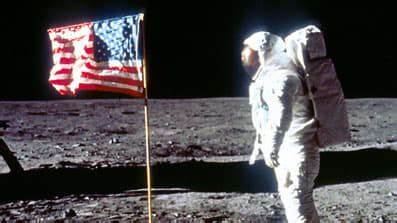(单词翻译:单击)
听力文本
Welcome to THE MAKING OF A NATION – American history in VOA Special English. I'm Steve Ember. On a cold October day in nineteen fifty-seven, the Soviet Union launched a small satellite into orbit around the Earth. Radio Moscow made the announcement. "The first artificial Earth satellite in the world has now been created. This first satellite was today successfully launched in the USSR." The world's first satellite was called Sputnik 1. Sputnik was an important propaganda victory for the Soviets in the Cold War with the United States. Many people believed the nation that controlled space could win any war. And the Soviet Union had reached outer space first.
The technology that launched Sputnik probably began in the late nineteenth century. A Russian teacher of that time, Konstantin Tsiolkovsky, decided that a rocket engine could provide power for a space vehicle. In the early nineteen hundreds, another teacher -- American Robert Goddard -- tested the idea. He experimented with small rockets to see how high and how far they could travel. In nineteen twenty-three, a Romanian student in Germany, Hermann Oberth, showed how a spaceship might be built and launched to other planets. Rocket technology improved during World War Two. It was used to produce flying bombs. Thousands of people in Britain and Belgium died as a result of V-1 and V-2 rocket attacks. The rockets were launched from Germany. The larger V-2 rocket had the ability to hit the United States. After the war, it became clear that the United States and the Soviet Union -- allies in wartime -- would become enemies in peacetime. So, both countries employed German scientists to help them win the race to space. The Soviets took the first step by creating Sputnik.

This satellite was about the size of a basketball. It got its power from a rocket. It orbited Earth for three months. Within weeks, the Soviets launched another satellite into Earth orbit, Sputnik 2. It was much bigger and heavier than Sputnik 1. It also carried a passenger: a dog named Laika. Laika orbited the earth for seven days. The United States joined the space race about three months later. It launched a satellite from Cape Canaveral, in the southeastern state of Florida. This satellite was called Explorer 1. It weighed about fourteen kilograms. Explorer 1 went into a higher orbit than either Sputnik. And its instruments made an important discovery. They found an area of radiation about nine hundred sixty kilometers above Earth. The next major space victory belonged to the Soviets. They sent the first man into space. In April, nineteen sixty-one, cosmonaut Yuri Gagarin was launched in the vehicle known as Vostok. He remained in space for less than two hours. He landed safely by parachute near a village in Russia.
Less than a month later, the United States sent its first astronaut into space. He was Alan Shepard. Shepard remained in space only about fifteen minutes. He did not go into Earth orbit. That flight came in February, nineteen sixty-two, with John Glenn. By nineteen sixty-five, the United States and the Soviet Union were experimenting to see if humans could survive outside a spacecraft. In March, Russian cosmonaut Alexei Leonov became the first person to do so. A strong tether connected Leonov to the spacecraft. The tether gave him oxygen to breathe. And it permitted him to float freely at the other end. After about ten minutes, Leonov had to return to the spacecraft. He said he regretted the decision. He was having such a good time! A little more than two months later, an American would walk outside his spacecraft. Astronaut Edward White had a kind of rocket gun. This gave him some control of his movements in space. Like Leonov, White was sorry when he had to return to his spacecraft. Later that year, nineteen sixty-five, the United States tried to have one spacecraft get very close to another spacecraft while in orbit. This was the first step in getting spacecraft to link, or dock, together. Docking would be necessary to land men on the moon. The plan called for a Gemini spacecraft carrying two astronauts to get close to an unmanned satellite.
重点解析
1.less than 不到;小于
We'll be there in less than no time.
我们马上就到。
2.return to 在家里;在国内
She's planning to return to work once the children start school.
她正计划孩子一入学就恢复上班。
3.be necessary to 对……有必要;为……所必要
It might be necessary to make a few slight modifications to the design.
也许有必要对这个设计稍作几处修改。
4.call for 要求;呼吁
Your plan will call for a lot of money.
你的计划需要许多钱。
参考译文
欢迎收听VOA慢速英语之建国史话节目,我是史蒂夫·恩伯。1957年10月一个寒冷的日子,苏联发射了一颗小卫星进入环绕地球的轨道,莫斯科电台宣布了这一消息。“世界上第一颗人造地球卫星现在已经诞生。第一颗卫星今天在苏联成功发射。”世界上第一颗卫星被称为“史普尼克一号”,史普尼克卫星是苏联与美国冷战中,在宣传方面取得的重要胜利。许多人认为,控制太空的国家可以赢得任何战争,苏联首先到达了外层空间。
发射史普尼克卫星的技术可能始于19世纪末,当时的一位俄罗斯教师康斯坦丁·齐奥科夫斯基认为,火箭发动机可以为太空飞行器提供动力。在19世纪初,另一位教师——美国人罗伯特·戈达德——对这个想法进行了测试。他用小型火箭做实验,看看它们飞行的高度和距离。1923年,一个在德国的罗马尼亚学生赫尔曼·奥伯思,展示了建造太空船并将其发射到其他行星的方式。火箭技术在第二次世界大战期间得到了改进,它被用来制造飞行炸弹。英国和比利时数千人死于V-1和V-2火箭袭击,火箭是从德国发射的,更大的V-2火箭有能力击中美国。战后,战时的盟友美国和苏联在和平时期会成为敌人,这一点变得很明显。因此,两国都聘请德国科学家帮助他们赢得太空竞赛。苏联人通过制造史普尼克号卫星迈出了第一步。
这颗卫星有篮球那么大,它的动力来自火箭,绕地球运行了三个月。几周内,苏联将另一颗人造卫星“史普尼克二号”送入地球轨道。它比史普尼克一号更大,也更重,上面还载有一名乘客:一只名叫莱卡的狗。莱卡围绕地球环绕了七天。大约三个月后,美国加入了这场太空竞赛。它从佛罗里达州东南部的卡纳维拉尔角发射了一颗卫星。这颗卫星被称为探索者一号,重约14公斤。探索者一号进入了比两颗史普尼克号卫星都高的轨道。它的仪器获得了重要发现。它们在地球上空大约960公里处发现了一个辐射区。在太空方面取得的另一个重大胜利属于苏联,他们第一次把人送入太空。1961年4月,宇航员尤里·加加林乘坐名为“沃斯托克”的运载火箭升空。他在太空呆了不到两个小时,他乘降落伞在俄罗斯一个村庄附近安全着陆。
不到一个月后,美国将其第一名宇航员送入太空,他就是艾伦·谢泼德。谢泼德在太空中只停留了大约15分钟,他没有进入地球轨道。那次飞行是在1962年2月,约翰·格伦是其搭档。到1965年,美国和苏联正在进行试验,看看人类能否在太空船外生存。同年3月,俄罗斯宇航员列昂诺夫成为第一个这样做的人。利昂诺夫与宇宙飞船之间有一条牢固的系绳,绳子为他提供呼吸的氧气,让他在另一端自由漂浮。大约十分钟后,列昂诺夫不得不返回飞船。他说,他对这个决定感到遗憾,他玩得非常开心!两个多月后,一个美国人走出飞船。宇航员爱德华·怀特配有一种火箭枪,这使他对自己在太空中的动作有了一些控制。和列昂诺夫一样,怀特在不得不返回飞船时也感到遗憾。1965年末,美国试图让一个航天器在轨道上非常接近另一个航天器,这是使航天器进行连接或停靠在一起的第一步。人类登陆月球需要对接,该计划要求双子座航天器上搭载两名宇航员以靠近无人卫星。
译文为可可英语翻译,未经授权请勿转载!


